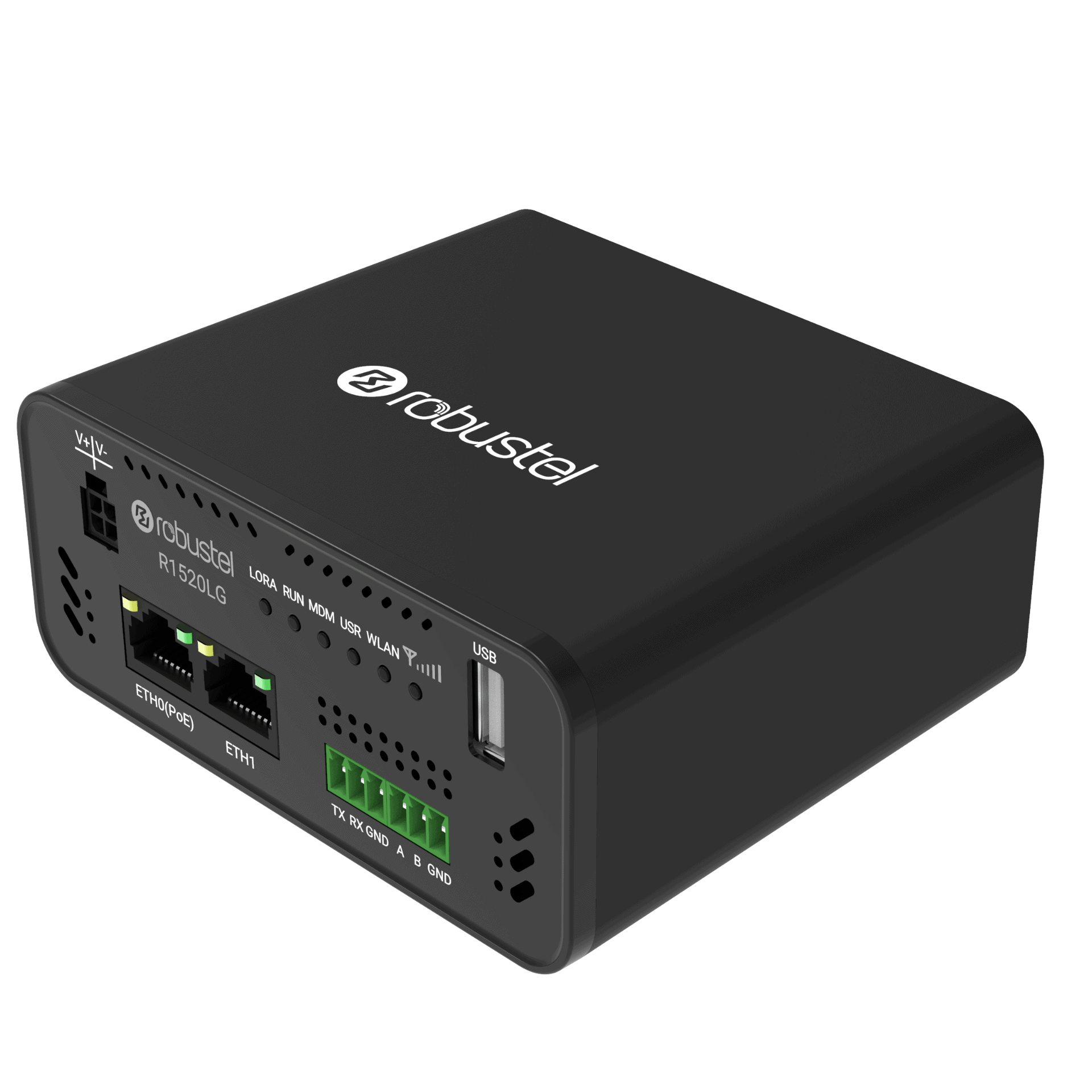LoRaWAN Smart Metering and Sub-Metering for Commercial, High-Rise and Apartment Buildings
A Robustel Application Example
Application Example – Fast Facts
Industry
Energy & Utilities, Commercial property, high-rise residential, multi-tenant apartments, mixed-use campuses
Product(s)
Robustel R1520-LG LoRaWAN Gateway; RCMS (RobustLink, RobustVPN)
Challenges
Building owners and service providers need accurate, regular consumption data electricity, water, gas, chilled water, HVAC load; from risers, basements, plant rooms, and remote enclosures. Those meters were rarely networked at install, and IT teams don’t want them on the corporate LAN.
Expected Outcomes
Deploy LoRaWAN sub-meters and sensors throughout the site. Use a single R1520-LG to collect all readings wirelessly and send them upstream over 4G/LTE. You get billable usage, alerts, and audit-ready records without sending staff floor-to-floor with a clipboard.
LoRaWAN Smart Metering and Sub-Metering
Modern building operation is no longer just “keep the lights on.” Owners are being asked to prove energy intensity per tenant, allocate water fairly between suites, and document consumption for ESG reporting and sustainability goals. In some regions, regulators and investors now expect landlords and operators to show how energy and water are being managed, not just paid for.
The problem is that most buildings weren’t designed for that level of transparency. Electrical sub-meters sit in locked risers. Water meters are buried in plant rooms. Gas flow sensors and chilled water meters sit at the edge of mechanical spaces nobody wants to open unless something breaks. Running Ethernet to all of those points is prohibitively expensive, especially in occupied buildings. Asking corporate IT for a new VLAN in every tower is slow and politically difficult.
This is where the Robustel R1520-LG earns its place. The R1520-LG acts as a LoRaWAN gateway inside the property. LoRaWAN sensors and sub-meters send their readings wirelessly from wherever they’re installed — through concrete, down risers, across service corridors — to the R1520-LG. The gateway then forwards that data securely over cellular to the customer’s billing, analytics, or energy management platform. No trenching, no tapping into the tenant network, and no manual reads once a month.
Business Challenges
Before you can automate billing and reporting, you have to solve some very old, very physical problems: access, trust, and scale. This is what building operators and metering service providers are dealing with day to day.
Before we talk about the design, it’s important to spell out what’s in the way.
- Meters live where networks don’t: Sub-meters for electricity, chilled water, steam, gas and HVAC load are often installed wherever the pipe or feed is accessible, not where IT infrastructure exists. That usually means riser cupboards, underground plant rooms, or locked service areas — places without structured cabling, Wi-Fi coverage, or spare power for networking gear.
- Manual reading doesn’t scale and doesn’t stand up in disputes: Walking the site to take photos of meters and re-key numbers introduces delay and human error. When a tenant disputes consumption or questions a service charge, “we wrote it down last Thursday” is not a strong position.
- Corporate IT does not want metering traffic on their LAN: Even in buildings with strong network coverage, facilities teams regularly hear “No, we’re not putting water meters on the finance VLAN” or “We can’t allow random serial gear on our switches.” You need a path that does not rely on winning that argument every time.
- ESG and compliance expectations are rising: Large commercial landlords and asset managers increasingly need to prove efficiency measures, track resource usage per tenant, and report on CO₂-linked consumption. You can’t produce that consistently if you only have main incomer data.
- Cost per point kills most retrofits: You might have 40, 80, even 150 sub-meters across a complex. If each one needs its own router, SIM, and install, the business case falls apart fast. You need one hub that can “hear” many meters with minimal on-site intervention.
Solution Overview
The property operator (or metering service provider) installed LoRaWAN-capable sub-meters and sensors across the building, then deployed a Robustel R1520-LG as the collection and uplink point. All usage data lands locally at the R1520-LG and is then pushed offsite over cellular. RCMS provides oversight across the entire estate.
- Local LoRaWAN network for metering and sensors: The R1520-LG acts as an on-site LoRaWAN gateway. LoRaWAN (Long Range Wide Area Network) is a low power wireless technology designed for industrial sensing across distance and through concrete. Electrical sub-meters, water meters, gas/steam flow sensors, leak detectors, temperature and humidity probes — all of these can transmit readings to the R1520-LG without needing Ethernet or Wi-Fi at the meter.
- One gateway, many points of measurement: Instead of asking you to put a router at every metering location, one R1520-LG can aggregate readings from many LoRaWAN sensors across multiple floors or adjacent buildings. That keeps install cost low enough to cover entire towers, commercial complexes, or campus-style sites.
- Cellular backhaul to your platform of record: The R1520-LG uses 4G/LTE to deliver structured data to whatever system you already trust for billing, energy analytics or sustainability tracking. There’s no need to negotiate with building IT for LAN access, and no security exposure from putting utility hardware on office infrastructure.
- Operational visibility with RCMS: All deployed R1520-LG gateways register into RCMS. That gives your operations team a single place to see which buildings are reporting, when each gateway last checked in, how strong the cellular link is, and whether configuration is consistent. If a building “goes dark,” you see it before invoicing or ESG reporting is affected.
- Repeatable deployment across your portfolio: Because the pattern is standard LoRaWAN sub-meters or sensors at the edge, R1520-LG as the collector, cellular as the uplink — service providers can roll this out across multiple properties without re-engineering the approach every time. That matters if you manage dozens of buildings under contract.
Expected Customer Outcomes
What success looks like for the Building Operator and the Integrator/Installer
For the building operator, asset owner, or metering service provider:
- Actual consumption by tenant, by riser, by floor, by process, not estimates from a main feed.
- An audit trail: timestamped interval data you can stand behind when someone challenges an allocation or service charge.
- Fewer manual rounds to read meters in awkward, sometimes unsafe locations.
- A cleaner position with corporate IT: metering traffic is off their LAN and under your control.
- Easier sustainability and ESG reporting, because usage data is continuous and centralised.
For the integration partner:
- A LoRaWAN + cellular pattern that is commercially viable to roll out in occupied high-rise and mixed-use sites.
- Ongoing operational relevance through RCMS, not just day-one hardware sales.
Featured Products
Robustel R1520-LG LoRaWAN Gateway

RCMS Cloud Device Management

Talk to an Expert
If you manage multi-tenant energy billing, environmental reporting, or resource accountability, you already know the hardest part isn’t “having meters.” It’s getting trustworthy data out of them, every day, without fighting IT or sending people floor by floor.
Let’s talk about how an R1520-LG LoRaWAN gateway can give you continuous, defensible sub-metering across commercial towers, high-rise residential, and mixed-use sites — all without rewiring the building.
